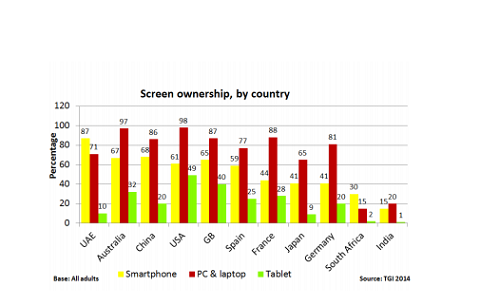 No longer the preserve of the youngest adults
No longer the preserve of the youngest adults
• Smartphone ownership over or approaching two thirds of adults in many developed markets, making multiscreening more common amongst older adults
• In Britain alone those in their late 30s/early 40s more likely than 18-24 year olds to watch TV whilst online
• Increasingly, no longer are the youngest adults the most likely to search online for products they have seen advertised on TV
As adoption of the technology required for multiscreening becomes mainstream in developed markets, young early adopter adults are no longer driving multiscreen
behaviour, reveals analysis of the latest TGI studies from Kantar Media.
With burgeoning penetration of tablets and smartphones, other age groups are becoming more significant drivers and adopters of multiscreen behaviours. For example, in the US, 49% of adults now claim to own a tablet and 61% a smartphone. Similarly, in Great Britain and Spain smartphone penetration is at 65% and 59% respectively, in China 68%, UAE 87% and in Australia 67%.
In Great Britain, TGI insights reveal that 35-44 year olds are almost a third more likely than the average adult to say they usually listen to or watch TV whilst online (55% of them do so), whereas 18-24 year olds are just under a quarter more likely (51% do so). The story in the US is similar and there is now a relatively flat profile for multiscreening across age groups. By contrast, in Germany, where penetration of smartphones and tablets is a little lower, the skew towards multiscreening amongst the younger age groups remains stronger.
Multiscreening is often directly encouraged by advertisers to drive instant purchase online. In both Great Britain and the US, it is not the youngest (18-24 year old) adults who are the most likely to search on the internet for products they have seen advertised on TV. In the US 41% of 25-34 year olds do so (compared to 38% of 18-24 year olds).
Similarly, TGI reveals that, in various markets, a similar proportion of older adults have found out about websites they regularly use from TV ads, as their younger counterparts. For example, in Germany, 8% of 18-24 year olds have done so, compared to 9% of 35-44 year olds.
These multiscreen findings are reinforced by results from Kantar Twitter TV Ratings, which suggest that it is not just the younger generation that multiscreen and take to Twitter to comment on their favourite shows. BBC1’s Question Time is always ranked amongst the top Tweeted-about programmes.

Traditionally, Question Time has an older skewing audience, with over two thirds of the viewers aged 55+ and viewers aged 35 or over nearly five times more likely to view it than 16-34 year olds. However, Kantar Media’s recent study “A Year in the Life of TV & Twitter in the UK” showed that an episode of Question Time was the 13th most Tweeted-about programme during an entire 12 month period.
Geoff Wicken, Head of TGI International, Kantar Media, comments: “Anyone who still thinks that multiscreening is a niche behaviour in developed countries is well behind the curve. Our TGI insights show that all age groups in many markets now have the tools to consume content on multiple devices simultaneously. It is no longer the youngest adults who are predominantly driving multiscreening or being prompted towards online purchasing by what they have seen on TV. Brands need to understand this is now very much mainstream behaviour and re-think their digital marketing strategies accordinglyto cater to a broad range of ages.


